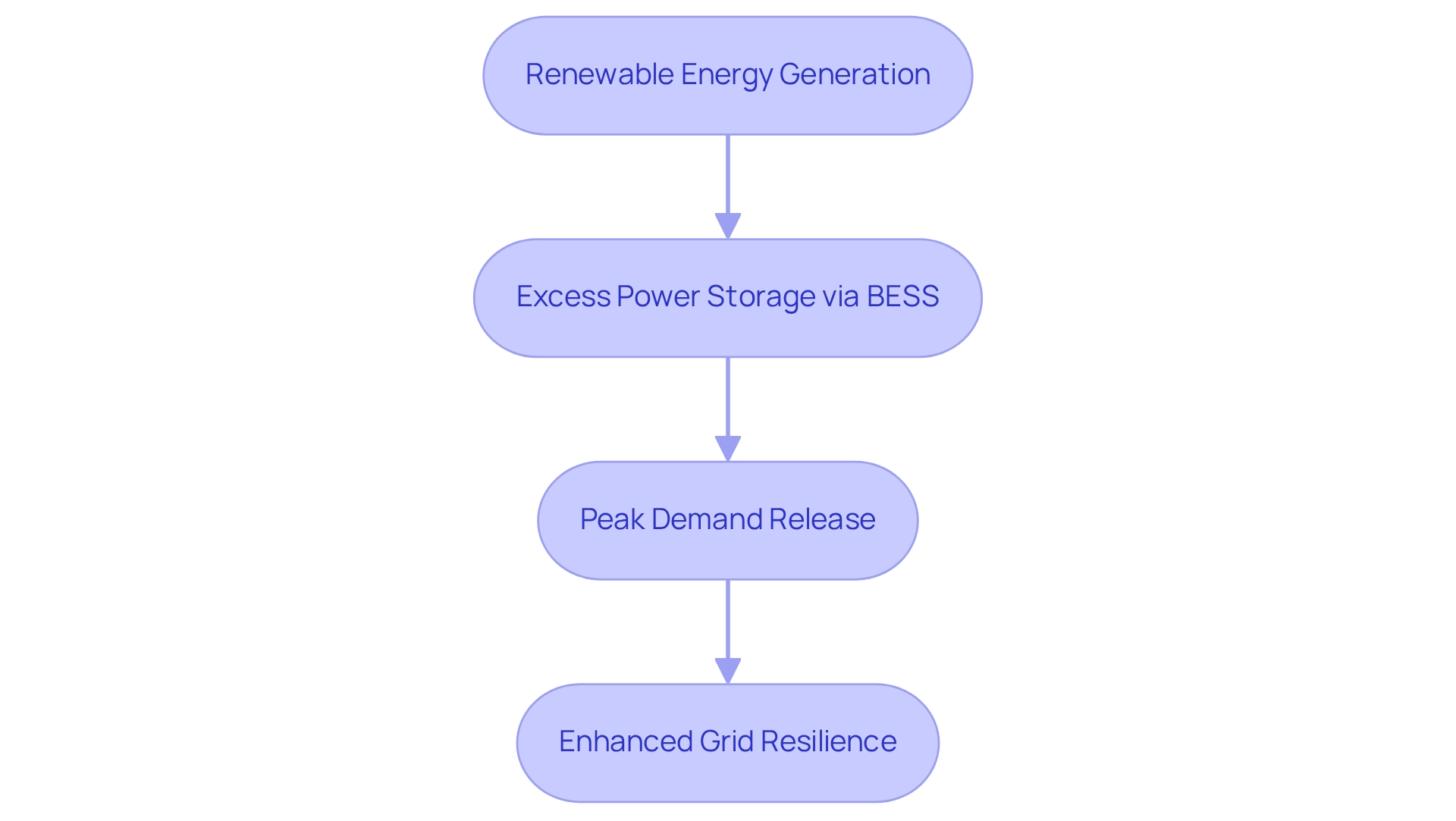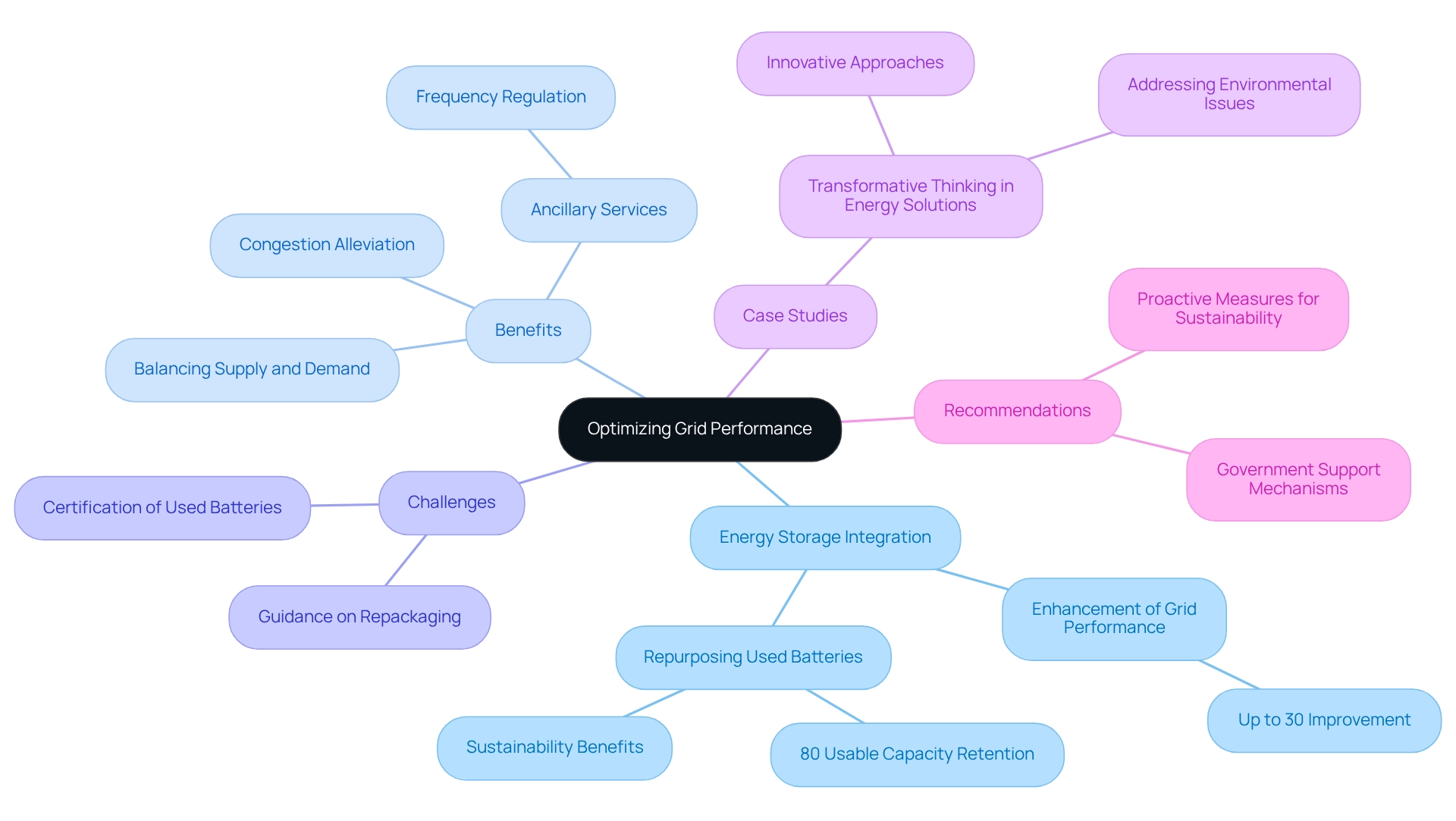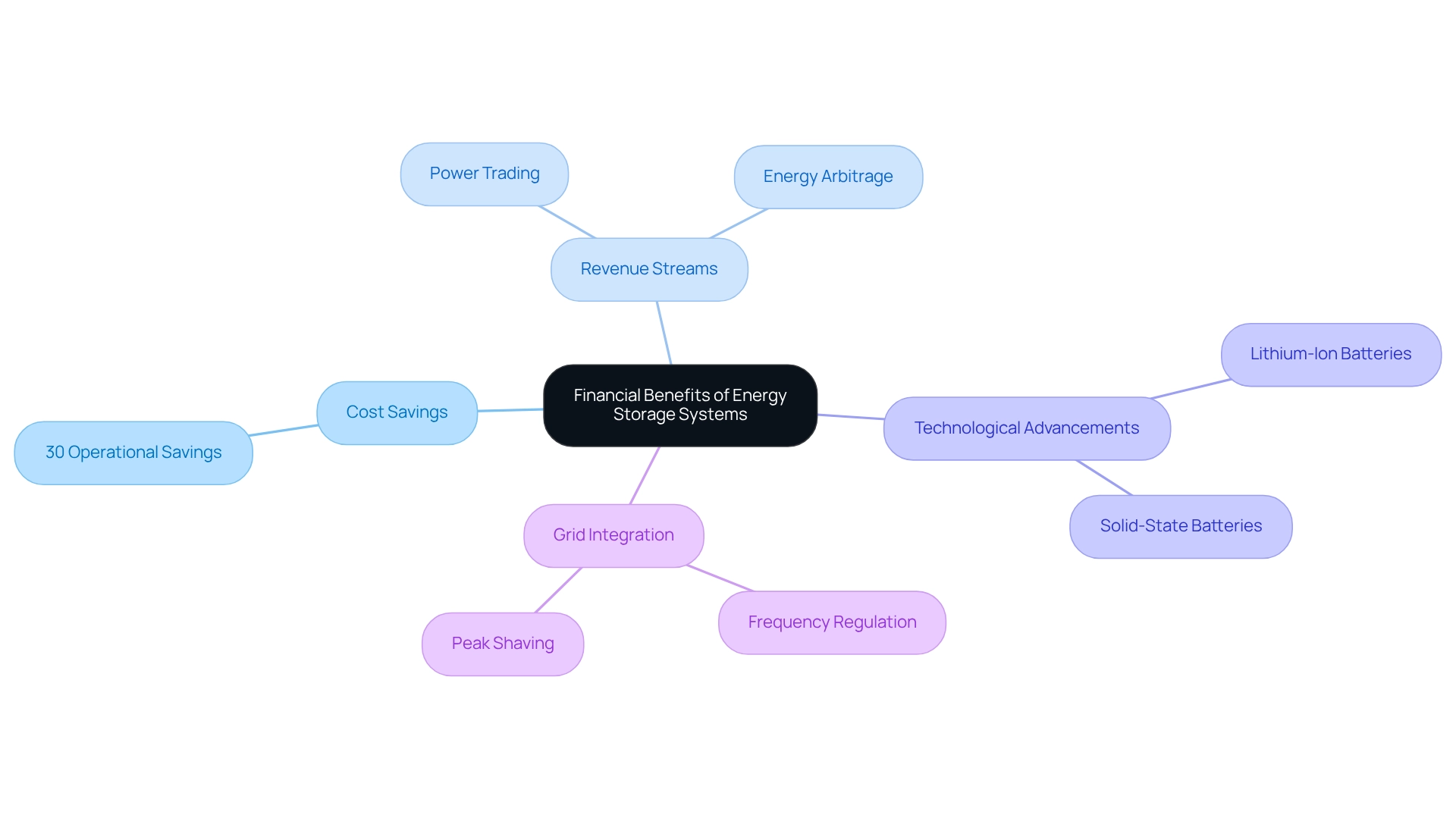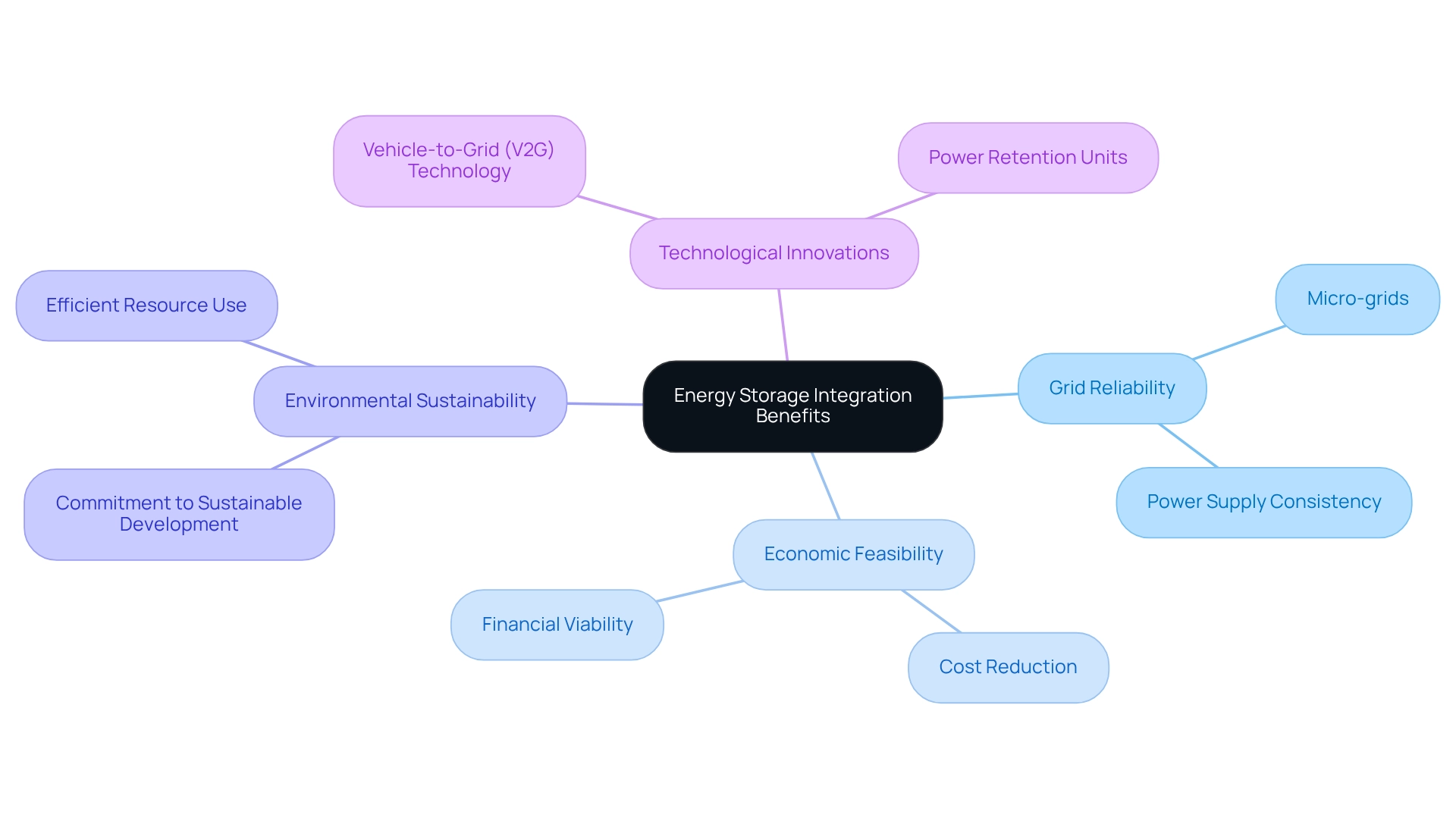Overview
The article underscores the critical strategies for effectively integrating energy storage into transmission projects, highlighting the essential role of collaboration among stakeholders, adept regulatory navigation, and the adoption of innovative technologies. These strategies not only enhance grid resilience but also optimize performance, ultimately paving the way for a sustainable energy future. This approach addresses the pressing need for efficient management of renewable resources, inviting stakeholders to consider the transformative potential of these practices.
Introduction
As the energy landscape undergoes a significant transformation towards sustainability, the integration of energy storage systems stands out as a pivotal element in enhancing grid resilience and optimizing renewable resources. Amid the dual pressures of climate change and the demand for reliable power, stakeholders are increasingly acknowledging the critical role that innovative technologies and strategic land services play in this transition.
Navigating regulatory challenges and leveraging advanced battery solutions illustrate the complexities of the journey towards a low-carbon grid, which necessitates collaboration and creative problem-solving. This article delves into the multifaceted benefits of energy storage integration, showcasing how it not only bolsters economic viability but also strengthens environmental commitments, ultimately paving the way for a more sustainable energy future.
Harbinger Land | Comprehensive Solutions for Land Services in Energy Storage Integration
Harbinger Land offers a comprehensive suite of land services that are vital for the effective implementation of power reserve initiatives. These services encompass site and right-of-way acquisition, meticulous title research, and advanced GIS mapping. Our seasoned team excels in negotiating and securing the necessary leases and easements for distributed power resources (DER) and infrastructure development. By utilizing highly integrated GIS modeling services, we facilitate efficient easements that save our clients both time and money.
This expertise not only streamlines project implementation but also significantly enhances the overall feasibility of power retention solutions. As energy storage integration into transmission continues to mitigate congestion in transmission and distribution infrastructure, thereby bolstering the resilience of the electrical network, the significance of efficient land acquisition becomes increasingly paramount. The declining costs of photovoltaic (PV) systems have the potential to transform the hub-and-spoke power model, further highlighting the necessity of strategic land services in this evolving landscape.
As Al Gore poignantly remarked, 'You see that pale, blue dot? That's us... it's our only home. And that is what is at stake.' This ethical imperative underscores the necessity for effective land procurement in power initiatives. Furthermore, community-driven renewable power initiatives in New Mexico exemplify how efficient land services can foster local engagement and accessibility in power projects.
Additionally, Harbinger Land employs sophisticated document imaging technologies to convert property information, enabling title agents to conduct title research and leasing processes effectively and affordably. This innovation further supports the seamless energy storage integration into transmission initiatives, ensuring that our clients can navigate the complexities of land acquisition with confidence.
Battery Energy Storage Systems: Enhancing Grid Resilience for Renewable Integration
The energy storage integration into transmission using Battery Storage Systems (BESS) is vital for enhancing grid resilience by efficiently storing excess power generated from renewable sources and releasing it during peak demand. This functionality stabilizes the grid and reduces the risk of outages, positioning BESS as a crucial component in the energy storage integration into transmission, leading towards a more reliable and sustainable power infrastructure. As Abigail Ross Hopper, president and CEO of the Solar Power Industries Association (SEIA), emphasizes, regions powered by solar energy are often overlooked, underscoring the importance of incorporating BESS in these contexts.
In 2025, data from SEIA and Wood Mackenzie Power & Renewables suggest that energy storage integration into transmission via BESS installations is expected to significantly improve grid resilience, enabling utilities to manage variations in power supply and demand more effectively. Expert insights reveal that energy storage integration into transmission through the implementation of BESS not only aids in integrating renewable resources but also fosters a more equitable power landscape, ensuring that all communities benefit from advancements in power technology. This aligns with Al Gore's perspective on the moral imperative of environmental action, as discussed in 'An Inconvenient Truth,' which highlights our collective responsibility to protect the planet.
Practical examples illustrate how BESS has been effectively utilized to enhance grid reliability, showcasing its essential role in energy storage integration into transmission and the ongoing development of the power industry.

Optimizing Grid Performance: The Strategic Role of Energy Storage in Renewable Projects
Energy retention systems play a crucial role in energy storage integration into transmission, optimizing grid performance, effectively balancing supply and demand, alleviating congestion, and delivering critical ancillary services such as frequency regulation. As we approach 2025, energy storage integration into transmission becomes increasingly vital within renewable initiatives, enabling developers to significantly enhance grid efficiency. Research indicates that energy storage integration into transmission can enhance grid performance measures by as much as 30%, ensuring the sustainable utilization of renewable power sources.
Moreover, energy storage integration into transmission is pivotal in stabilizing the fluctuations in supply and demand, particularly as renewable sources like solar and wind become more prevalent. With batteries that no longer meet electric vehicle standards still retaining up to 80% of their usable capacity, there lies a substantial opportunity to repurpose these resources for grid applications. This approach not only fosters sustainability but also addresses the pressing need for clear guidance on the repackaging and certification of used batteries.
Successful case studies, such as 'Transformative Thinking in Energy Solutions,' underscore the revolutionary impact of power retention on grid performance. This case study demonstrates how innovative methods can effectively meet power demands while addressing environmental challenges. Experts in the field advocate for enhancing grid efficiency through energy storage integration into transmission, emphasizing that such actions are crucial for protecting our power infrastructure. Furthermore, governmental support systems are recommended to promote the implementation of energy storage integration into transmission, reinforcing its essential role in the current power framework. As Robert Swan wisely noted, the most significant threat to our planet is the belief that someone else will save it; thus, proactive measures in power conservation are imperative for a sustainable future. Leaders in Land Acquisition should consider these insights and explore specific strategies for energy storage integration into transmission to enhance grid efficiency.

Navigating Regulatory Challenges: Energy Storage Integration in Renewable Projects
Incorporating power retention into renewable initiatives presents numerous regulatory hurdles, including permitting, interconnection standards, and compliance with local and federal regulations. With the microgrid market projected to reach $47.4 billion by 2025, grasping these complexities is vital for stakeholders. Current authorization timelines for power retention initiatives can vary significantly, often extending beyond initial forecasts due to evolving policies and regulatory scrutiny.
To navigate these challenges effectively, stakeholders must engage proactively with regulatory bodies and remain informed on compliance updates. Recent insights from regulatory authorities underscore the necessity of viewing energy reserves as complementary assets rather than competitors to traditional generation and network resources. As Giorgio Castagneto Gissey noted, a market framework that recognizes the flexibility provided by reserves is essential for facilitating seamless execution and fostering a more favorable regulatory environment.
Case studies illustrate successful management of permitting processes, demonstrating that proactive involvement and thorough knowledge of permitting requirements can lead to timely approvals. As we approach 2025, staying attuned to compliance updates and regulatory changes is crucial for ensuring that storage initiatives align with current standards, ultimately paving the way for a sustainable power future.

Demand-Side Management: Key to Successful Renewable Resource Integration
Demand-side management (DSM) is pivotal in the effective integration of renewable resources, enabling utilities to optimize usage patterns. By implementing DSM strategies, such as load shifting and peak shaving, utilities can significantly decrease peak demand, enhance grid stability, and maximize the utilization of renewable power sources. This ultimately leads to a more efficient power system.
A recent gathering of over 50 specialists in the field on May 14, 2024, highlighted the rapid expansion of efficiency initiatives, underscoring DSM's vital role in modern strategies. This engagement reflects the urgent necessity for utilities to embrace innovative approaches to demand flexibility. The involvement of the private sector in markets like India illustrates how technological advancements can stimulate investment and innovation in DSM strategies.
Utilities are increasingly acknowledging the benefits of DSM strategies, with many reporting favorable outcomes from their application. These strategies not only optimize power usage but also promote energy storage integration into transmission of renewable resources, ensuring that clean power microgrids function effectively. As Elisa Wood, Editor-in-Chief, points out, there is growing concern that an economic downturn could impede progress in clean technologies, thereby amplifying the importance of DSM in sustaining momentum for renewable integration initiatives.
In conclusion, the significance of demand-side management in the integration of renewable resources is paramount. It serves as a crucial tool for utilities aiming to enhance efficiency, reduce peak demand, and ultimately foster a more sustainable power landscape.

Innovative Technologies: Driving Energy Storage Solutions for Renewable Integration
Innovative technologies are revolutionizing power retention systems, with advanced battery chemistries and artificial intelligence playing pivotal roles in this transformation. These advancements significantly enhance the efficiency, reliability, and scalability of power storage solutions, thereby supporting energy storage integration into transmission and enabling a more robust integration of renewable power sources into the grid.
The demand for critical minerals essential for battery production is projected to surge, necessitating sustainable mining and recycling efforts to meet this demand. Addressing supply chain issues and regulatory obstacles, as highlighted in recent studies, is crucial; without these efforts, the advancement of battery technologies may stagnate, jeopardizing power security and affordability in the transition to cleaner power sources.
Focused policies can promote the expansion of battery recycling, particularly with recognized global standards, ensuring that batteries can effectively engage in power markets and are appropriately rewarded for their contributions to the electricity network.
As the landscape of power retention continues to evolve, the integration of AI in power management frameworks is emerging as a transformative factor, enhancing performance and broadening the practical applications of power retention solutions.

Financial Benefits: How Energy Storage Systems Enhance Project Viability
Power retention solutions present significant financial advantages, including substantial reductions in operational expenses. Research indicates that companies can achieve operational cost savings of up to 30% through effective power management strategies. Additionally, these solutions create new revenue streams through trading. By strategically storing power during low demand and selling it during peak periods, developers can significantly enhance their return on investment. Noteworthy advancements in power retention technologies, such as lithium-ion and solid-state batteries, are enhancing the performance and efficiency of commercial solutions, rendering them increasingly viable and cost-effective for renewable initiatives. These innovations are expected to expand the capabilities of power retention solutions, further underscoring their importance in improving project feasibility.
Moreover, the energy storage integration into transmission involves the use of grid-interactive battery solutions to provide essential grid services, including frequency regulation and peak shaving. This not only supports grid stability but also yields financial benefits for developers. As competition in the power market intensifies, investing in these systems positions businesses advantageously while aligning with the growing demand for sustainable energy solutions. Financial analysts, including Luci Pai, emphasize that "energy arbitrage can significantly enhance project viability, making power retention an essential element of contemporary renewable initiatives.

Transitioning to a Low-Carbon Grid: The Role of Energy Storage in Renewable Projects
Energy storage integration into transmission is essential for the transition to a low-carbon grid, as it facilitates the efficient integration of renewable energy sources and reduces reliance on fossil fuels. Power management systems provide a reliable means of storing and distributing renewable resources, which aids in lowering greenhouse gas emissions and contributes to the overarching goal of achieving a sustainable future. For instance, the enhancements in natural gas capacity at the Intermountain Power Project will replace 1,800 MW of coal-fired capacity, exemplifying a significant move towards cleaner energy solutions and underscoring the critical role of power retention in this transition.
The economic feasibility of grid-scale solutions is often hindered by outdated market conditions, highlighting the need for updated regulatory frameworks to make these investments more appealing. The case study on the economic viability of grid-scale solutions illustrates that increasing incentives for flexibility and allowing value stacking can significantly bolster the business case for power reserves, making them a more attractive option for utilities and developers.
Environmental advocate Elizabeth May aptly states, "Once you have a solar panel on a roof, power is free." This assertion underscores the transformative potential of renewable resources and the role of power retention in reducing costs and reshaping consumption patterns. This transformation emphasizes the importance of power retention in progressing towards a sustainable energy future, where renewable resources can be utilized efficiently and effectively.
By 2025, the impact of power retention on reducing greenhouse gas emissions will become increasingly apparent, as utilities adopt these technologies to facilitate low-carbon grid transitions. The energy storage integration into transmission is not merely a technical necessity; it is a strategic imperative for achieving a sustainable energy framework.

Stakeholder Collaboration: Essential for Successful Energy Storage Integration
The successful incorporation of storage systems hinges on the efficient cooperation among a diverse array of stakeholders, including utilities, regulators, developers, and community members. It is essential to recognize that open communication is paramount; it not only addresses the concerns of all parties involved but also fosters a collaborative environment that is conducive to innovative solutions. Studies indicate that firms promoting cooperative efforts are five times more likely to achieve high performance, underscoring the significance of collaboration in such initiatives.
Moreover, case studies illustrate that creativity plays a crucial role in enhancing collaboration, boosting productivity, and ultimately leading to successful outcomes. Initiatives that encourage imaginative contributions from all participants often cultivate confidence and a shared objective, which provides a competitive advantage in the power industry. This ingenuity is vital for navigating the complexities of power integration, as it yields innovative solutions that can greatly enhance implementation.
Expert opinions further emphasize that effective communication strategies are indispensable for navigating the intricacies of energy storage integration into transmission. Industry leaders assert that prioritizing clear and consistent dialogue among stakeholders can significantly improve execution and community involvement. Nitin Nohria, former dean of Harvard Business School, articulated that "communication is the real work of leadership," reinforcing the critical role of dialogue in stakeholder collaboration.
In light of recent developments, utilities and regulators are increasingly acknowledging the necessity for standardized metrics to evaluate stakeholder participation. Future research should prioritize the development of these metrics, integrating both quantitative and qualitative data to assess collaboration success. This shift not only enhances transparency but also ensures that community involvement is meaningful and impactful, ultimately leading to more favorable outcomes.
To implement effective communication strategies, stakeholders should establish regular check-ins and feedback loops, ensuring that all voices are acknowledged and considered throughout the initiative lifecycle. This approach not only strengthens connections but also fosters a culture of teamwork that is essential for the success of resource integration.
Comprehensive Impact: The Benefits of Energy Storage Integration in Renewable Projects
Incorporating storage solutions into renewable initiatives delivers substantial benefits, including increased grid reliability, improved economic feasibility, and a commitment to environmental sustainability. These frameworks foster the efficient use of renewable resources, contributing to a more resilient and effective power landscape. Notably, hybrid networks can establish micro-grids, particularly in isolated regions, enhancing power supply reliability and ensuring consistent access to electricity. A structured literature review identified 54 articles that underscore the transformative potential of power conservation in optimizing electrical frameworks.
Moreover, the integration of intelligent solutions, such as vehicle-to-grid (V2G) technology, alongside power retention units has yielded promising results. These innovations not only bolster power network reliability but also provide solutions for peak shaving, ultimately elevating overall efficiency. As Gro Harlem Brundtland aptly stated, "Sustainable development is the development that meets the needs of the present without compromising the ability of future generations to meet their own needs." This philosophy underscores the importance of power retention in fostering a sustainable future for resources.
Recent updates indicate that power retention solutions are increasingly financially viable, with technological advancements reducing costs and enhancing performance. This economic feasibility is crucial for utilities as they strategize for the future. Data reveals that power retention significantly enhances grid dependability, establishing it as a vital component in the transition to sustainable energy. Successful instances of energy storage integration into transmission illustrate its capacity to stabilize the grid and meet the rising demand for clean energy solutions, reinforcing the imperative for utilities to incorporate these systems into their infrastructure planning.

Conclusion
The integration of energy storage systems represents a pivotal element in the transition toward a more sustainable energy future. By enhancing grid resilience, optimizing renewable resource utilization, and tackling regulatory challenges, energy storage technologies are fundamentally transforming the energy landscape. These systems offer not only economic benefits, such as operational cost reductions and new revenue streams, but they also play a crucial role in environmental sustainability by lowering greenhouse gas emissions and facilitating the move away from fossil fuels.
Collaboration among stakeholders is essential in this transformation, fostering innovative solutions and improving project execution. The success of energy storage integration relies on open communication and a unified vision among utilities, regulators, project developers, and communities. As the energy market evolves, embracing strategic partnerships and creative problem-solving becomes vital for addressing challenges and maximizing the advantages of energy storage.
Ultimately, adopting energy storage solutions is not just a technical necessity; it is a strategic imperative that aligns with the global commitment to establishing a low-carbon, resilient energy grid. As technological advancements continue to reduce costs and enhance performance, the significance of energy storage will only grow. Embracing these systems is crucial for ensuring a reliable, efficient, and sustainable energy future for all.
Frequently Asked Questions
What services does Harbinger Land provide for energy storage integration?
Harbinger Land offers a comprehensive suite of land services including site and right-of-way acquisition, title research, and advanced GIS mapping to facilitate power reserve initiatives.
How does Harbinger Land assist in negotiating leases and easements?
Harbinger Land's experienced team excels in negotiating and securing the necessary leases and easements for distributed power resources and infrastructure development, utilizing integrated GIS modeling services for efficiency.
Why is efficient land acquisition important for energy storage integration?
Efficient land acquisition is crucial as it streamlines project implementation and enhances the feasibility of power retention solutions, especially as energy storage continues to mitigate congestion in transmission and distribution infrastructure.
What impact do declining costs of photovoltaic systems have on land services?
The declining costs of photovoltaic systems could transform the hub-and-spoke power model, highlighting the necessity of strategic land services in adapting to this evolving energy landscape.
How does Harbinger Land use technology to improve land services?
Harbinger Land employs sophisticated document imaging technologies to convert property information, enabling title agents to conduct title research and leasing processes effectively and affordably.
What is the role of Battery Energy Storage Systems (BESS) in enhancing grid resilience?
BESS enhances grid resilience by efficiently storing excess power from renewable sources and releasing it during peak demand, stabilizing the grid and reducing outage risks.
What are the expected benefits of BESS installations by 2025?
By 2025, BESS installations are expected to significantly improve grid resilience, enabling utilities to manage power supply and demand variations more effectively.
How do energy storage systems optimize grid performance?
Energy storage systems optimize grid performance by balancing supply and demand, alleviating congestion, and providing critical ancillary services like frequency regulation.
What opportunities exist for repurposing used batteries in energy storage?
Batteries that no longer meet electric vehicle standards can still retain up to 80% of their usable capacity, presenting an opportunity to repurpose them for grid applications, promoting sustainability.
What is the significance of governmental support for energy storage integration?
Governmental support is recommended to promote the implementation of energy storage integration into transmission, reinforcing its essential role in enhancing grid efficiency and protecting power infrastructure.
List of Sources
- Harbinger Land | Comprehensive Solutions for Land Services in Energy Storage Integration
- utilitydive.com (https://utilitydive.com/news/12-unforgettable-quotes-from-nrg-energy-ceo-david-crane/227117)
- 20 Quotes To Get You Inspired For a Renewable Future - Solstice (https://solstice.us/solstice-blog/20-quotes-for-a-renewable-future)
- Clean Energy Storage Facts | ACP (https://cleanpower.org/facts/clean-energy-storage)
- Battery Energy Storage Systems: Enhancing Grid Resilience for Renewable Integration
- SEIA’s Vision for American Energy Storage – SEIA (https://seia.org/research-resources/seias-vision-for-american-energy-storage)
- 20 Quotes To Get You Inspired For a Renewable Future - Solstice (https://solstice.us/solstice-blog/20-quotes-for-a-renewable-future)
- Optimizing Grid Performance: The Strategic Role of Energy Storage in Renewable Projects
- Energy storage - IEA (https://iea.org/energy-system/electricity/grid-scale-storage)
- Empowering the Future: The Most Inspirational Quotes About Battery Energy Storage (https://eszoneo.com/info-detail/empowering-the-future-the-most-inspirational-quotes-about-battery-energy-storage)
- Navigating Regulatory Challenges: Energy Storage Integration in Renewable Projects
- Regulatory challenges & opportunities for Energy Storage in India (https://linkedin.com/pulse/regulatory-challenges-opportunities-energy-storage-budhavarapu)
- Navigating the Challenges of Energy Storage Systems (https://sgs.com/en-ug/news/2025/03/cc-2025-q1-navigating-the-challenges-of-energy-storage-systems)
- Renewable Energy Integration (https://meegle.com/en_us/topics/sustainable-energy/renewable-energy-integration)
- Market and regulatory barriers to electrical energy storage innovation | Request PDF (https://researchgate.net/publication/322863108_Market_and_regulatory_barriers_to_electrical_energy_storage_innovation)
- Demand-Side Management: Key to Successful Renewable Resource Integration
- What We Heard You Say…This Week’s Best and Worst Quotes about Energy Efficiency (https://microgridknowledge.com/uncategorized/article/11433861/what-we-heard-you-say8230this-week8217s-best-and-worst-quotes-about-energy-efficiency)
- Doubling Down on Efficiency and Ramping up Renewables: How Demand-Side Management Can Power Up India's Energy Goals (https://seforall.org/events/doubling-down-on-efficiency-and-ramping-up-renewables-how-demand-side-management-can-power)
- Innovative Technologies: Driving Energy Storage Solutions for Renewable Integration
- Executive summary – Batteries and Secure Energy Transitions – Analysis - IEA (https://iea.org/reports/batteries-and-secure-energy-transitions/executive-summary)
- Financial Benefits: How Energy Storage Systems Enhance Project Viability
- Commercial Energy Storage Systems - A Guide (https://solarbatterymanufacturer.com/commercial-energy-storage-systems-2)
- Lithium-ion Battery Energy Storage and Emerging Risks for Business | Travelers Insurance (https://travelers.com/resources/business-industries/energy/lithium-ion-battery-energy-storage-emerging-risks-business)
- Transitioning to a Low-Carbon Grid: The Role of Energy Storage in Renewable Projects
- Energy storage - IEA (https://iea.org/energy-system/electricity/grid-scale-storage)
- Solar, battery storage to lead new U.S. generating capacity additions in 2025 - U.S. Energy Information Administration (EIA) (https://eia.gov/todayinenergy/detail.php?id=64586)
- 60 Quotes About the Future of Renewable Energy (https://deliberatedirections.com/renewable-energy-quotes)
- Stakeholder Collaboration: Essential for Successful Energy Storage Integration
- What Statistics Indicate the Impact of Community Participation on Energy Project Success? → Question (https://sustainability-directory.com/question/what-statistics-indicate-the-impact-of-community-participation-on-energy-project-success)
- 35 Quotes about Communication to Inspire Collaboration | Vibe (https://vibe-portal-web.vercel.app/blog/35-quotes-about-communication)
- Inspiring quotes to foster collaboration and teamwork (https://hellobonsai.com/blog/collaboration-quotes)
- Comprehensive Impact: The Benefits of Energy Storage Integration in Renewable Projects
- 60 Quotes About the Future of Renewable Energy (https://deliberatedirections.com/renewable-energy-quotes)
- Impacts of Energy Storage System on Power System Reliability: A Systematic Review (https://mdpi.com/1996-1073/11/7/1749)
- 20 Quotes To Get You Inspired For a Renewable Future - Solstice (https://solstice.us/solstice-blog/20-quotes-for-a-renewable-future)




